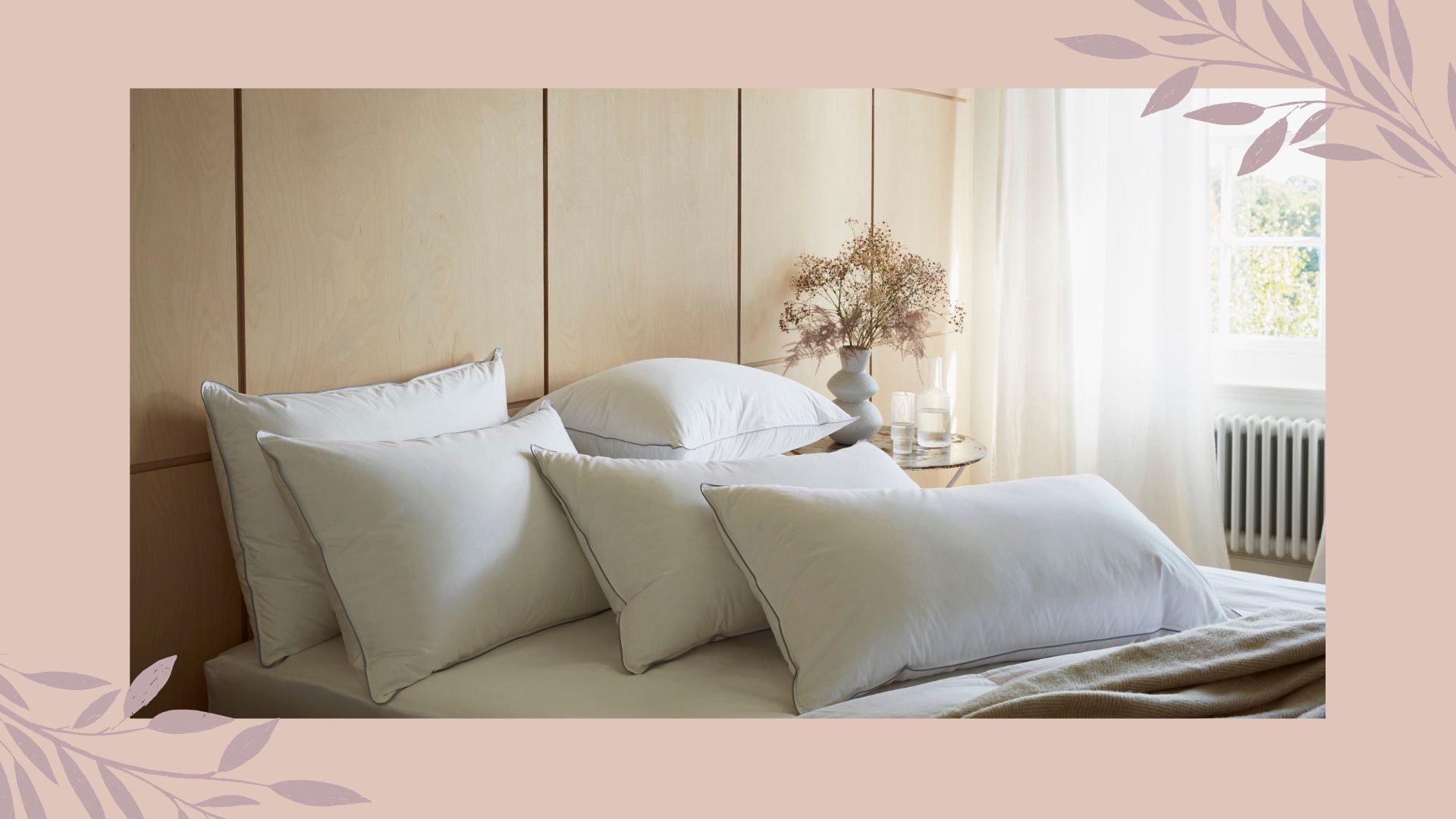How often should you change your pillows? We ask sleep experts
If you're wondering how often you should change your pillows, look no further, as experts reveal the optimum amount for better hygiene


We all know how important your mattress is to a good night’s sleep but let's not forget that your pillow is equally as important. That said, even the best pillow doesn't last forever so how often should you change your pillows and why?
There are a number of reasons that it could be time to change your pillows, with some more obvious than others. If you're waking up with aches and pains, or can't seem to find a comfortable position to drift off to dreamland, it's an obvious sign it is time for a new one.
Whereas if your beloved best pillow feels as good as new but it's years old, it could be less obvious that it may need replacing which is often the case also when it comes to replacing your mattress.
If you feel that you're not getting the best from your pillow anymore, take a look at our expert guidance on how often you should consider changing your pillows.
How often should you change your pillows?
So how often should you change your pillows? Your pillow can absolutely impact the quality of your rest. As such, a qualified team of physicians, academic researchers, and other sleep experts at the Sleep Foundation recommend generally replacing it every one or two years.
Independently w&h asked Emily Attwood, co-founder of luxury bedding specialists Scooms who agreed, saying: "Pillows get a lot of punishment, and as a result, we also recommend changing your pillow every one to two years."
If that seems excessive, consider how much use it gets in that time. Every single night, your pillow accumulates dead skin cells, sweat, oils, saliva, makeup residue, and allergens.
Sign up for the woman&home newsletter
Sign up to our free daily email for the latest royal and entertainment news, interesting opinion, expert advice on styling and beauty trends, and no-nonsense guides to the health and wellness questions you want answered.
The time frame for how often should you change your pillows can also vary depending on their filling. As hygiene expert, Dr. Hana Patel, a resident sleep expert at Time4Sleep explains: "You should replace your pillows every year or two depending on the material they're made from and sooner if you're particularly sensitive to allergies."
So how often should you replace your pillows depending on what type you have?
- Polyester and synthetic down: These are some of the most common pillows on the market. Based on how well they're maintained, they can last anywhere from six months to two years.
- Down: The fill makes down pillows (often the filling used in hotel pillows) reasonably durable. Still, these pillows should be replaced every one to three years.
- Memory foam and latex: Depending on the quality, memory foam and latex pillows can last three years or more.
If that “ick-factor” isn't enough to persuade you, remember that the structure of your pillow breaks down over time. When it loses its fluff and form, it becomes less supportive of your head and neck. Using the right pillow for your needs may mean the difference between restful slumber and a night of tossing and turning so it's essential for a good night's sleep.
We are of course only talking about replacing the pillows you actually use to aid sleep, you may have several pillows that are there purely there for show, to make your bedroom feel like a luxury hotel.

Why do pillows turn yellow?
It's an unpleasant fact, but over time pillows will start to discolor and you may notice that the white casing has started to turn slightly yellow in color. Don't panic, this is normal albeit a bit more than a little unsightly.
To explain why we asked Dr. Hana Patel who told w&h: "Pillows turn yellow after they absorb saliva, sweat, natural oils from our body, and skincare products we use ahead of bedtime."
"A pillow protector can help reduce the yellow staining, however, it's advisable to wash both your pillow and protector regularly to reduce this build-up. You should aim to wash your pillow once or twice a year and wash the pillow cover or pillow protector several times a month," Dr. Patel advises.
How not changing your pillow could be affecting your well-being
Besides affecting the quality of your sleep (and we all want to know how to sleep better), your pillow can also impact your well-being if you don't change it often enough. But, how?
Your pillow is a perfect breeding ground for dust mites, which devour your dead skin cells and thrive in environments that are warm and humid. The microscopic mites aren't dangerous, but they can trigger eczema for some and aggravate allergy symptoms in others.
It's worth noting that for most people, the fungi in pillows are harmless. But, for people with asthma, other chronic respiratory diseases, or immunocompromised systems, it may cause significant ill effects.
As Dr. Patel explains: "Over time our pillows will collect dust mites, fungi, mold as well as oil from our face and scalp which can lead to acne," explains Dr. Patel. Dirt and dust can also cause allergy symptoms to flare from itchy eyes to a runny nose and in some cases, difficulty breathing."
A good pillow should also keep your head and neck in alignment with your spine when you sleep. In fact, it's one of the reasons choosing the best pillow for neck pain is so important. It's important to make sure you're using the right density for your sleep position.
Snoozing on the wrong pillow can cause serious back and neck strain. This is particularly vital for traveling too – you should always make sure you have the best travel pillow to hand to prevent injuries or strain when on the road.
If you typically sleep on your side, you'll need one of the best pillows for side sleepers which are typically thicker, firmer pillows to provide enough support for your neck.
Stomach sleepers need to make sure their pillows are reasonably flat, so their necks don’t get hyperextended backward. The best cooling pillows can be a great option for this. And, if you sleep on your back, you'll need a pillow that’s firm enough to prevent your head from sinking too much and soft enough to ensure that your neck isn't arched too far forward.

How do you know that you need a new pillow
"For a good night's sleep, your pillow should support your head and neck comfortably, so if you're waking up with a stiff neck or your pillow is too flat or lumpy, then it's time for a change," says Emily.
A simple test will tell you for sure If there are no obvious signs to suggest you may benefit from a new pillow.
Balance your pillow on your forearm to see how much it folds in half, a plump pillow should give a little but not fold like a piece of origami – this would be a clear sign that it's time for a new one.
Clean, newer pillows are also a must for anyone that struggles with acne. But, how do you tell when your pillow might be making your skin worse and needs replacing? And how often should you change your pillows if you suffer from bad skin?
If you wash your pillows often, consistently remove your makeup and cleanse your face before bed but still wake up with breakouts, your pillow may be to blame. All the dirt and oil your pillow absorbs night after night can clog your pores (and cause blemishes). Because of this people with acne should consider changing their pillows more frequently than the advised one to two-year guidance.
Here are some other signs your pillow needs replacing:
- It's stained and dingy looking, even after washing
- You wake up with a stiff, achy neck or tight, cramped shoulders
- You suffer from throbbing headaches every morning
- You experience congestion, sneezing, or an itchy throat every night
- Your pillow feels flat or lumpy
How to prolong the life of your pillow
There are some things you can do to make your pillow last longer:
- Make it a habit to wash your pillow every six months to get rid of odors and pesky dust mites
- If your washer is large enough, wash two pillows at a time to balance the load. Use the hottest cycle recommended and a gentle detergent
- Memory foam and latex pillows can't be washed, so be sure to check the laundry label before tossing your pillow into the washing machine
- Add a few tennis balls to the dryer to keep the filling from clumping
- You can even speed up the drying time by throwing in a couple of dry towels. Make sure your pillow is completely dry to prevent mold and mildew from forming
- We also recommend using a protective pillow cover, to act as an additional barrier, under your pillowcase

Tamara is a highly experienced homes and interiors journalist with a career spanning over 22 years. Now the Lifestyle Editor of womanandhome.com, she previously spent 18 years working with the style teams at Country Homes & Interiors and Ideal Home. With these award-winning interior teams, she gained a wealth of knowledge and honed her skills and passion for styling and writing about every aspect of lifestyle and interiors.
A true homes and interiors expert, Tamara has been an ambassador for leading interior brands on multiple occasions, including appearing on Matalan’s The Show and presenting at top interior trend forecasting events such as the Autumn Fair and Spring Fair.
-
 Consider your next hairstyle sorted, as Cate Blanchett just debuted the chicest Italian bob
Consider your next hairstyle sorted, as Cate Blanchett just debuted the chicest Italian bobIf you could capture a Portofino summer in hairstyle form, it would look exactly like Cate Blanchett's bob
By Naomi Jamieson
-
 FatFace is a must-visit destination for holiday essentials - and the denim will have you heading to the checkout too
FatFace is a must-visit destination for holiday essentials - and the denim will have you heading to the checkout tooGo for the holiday shop, stay for the denim
By Caroline Parr